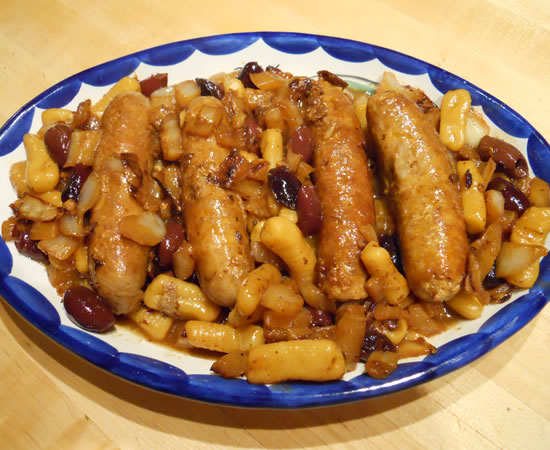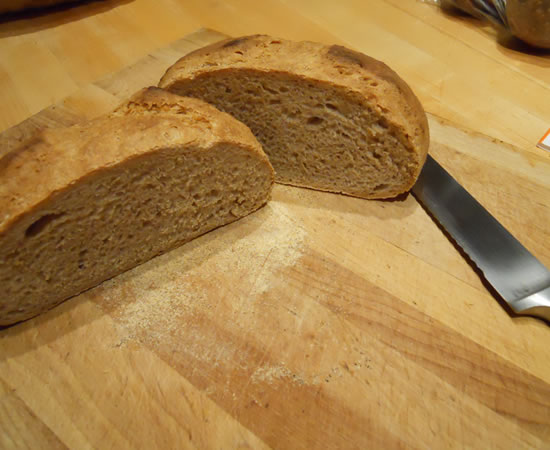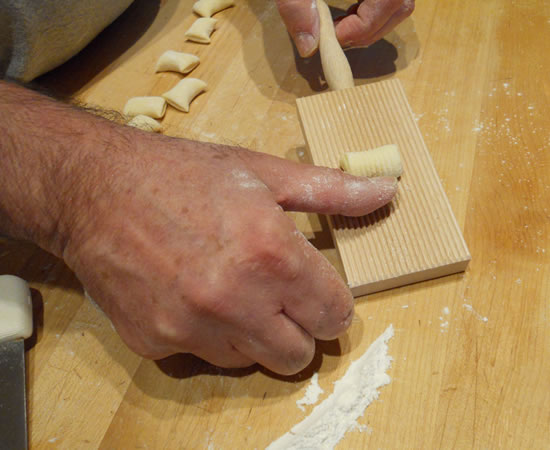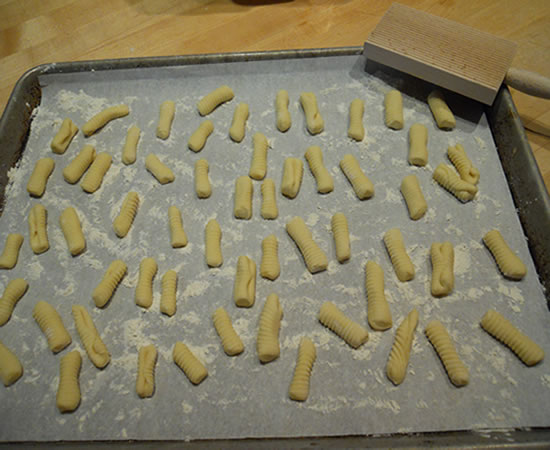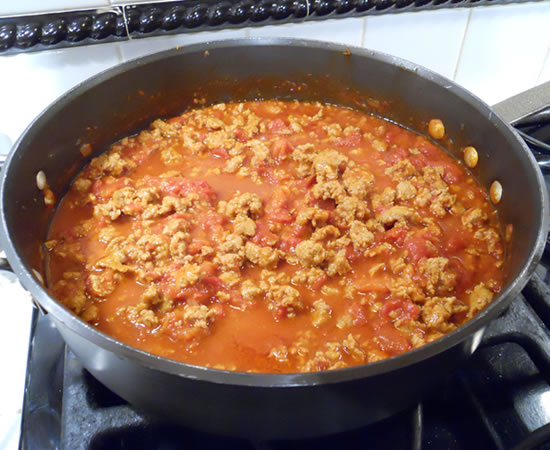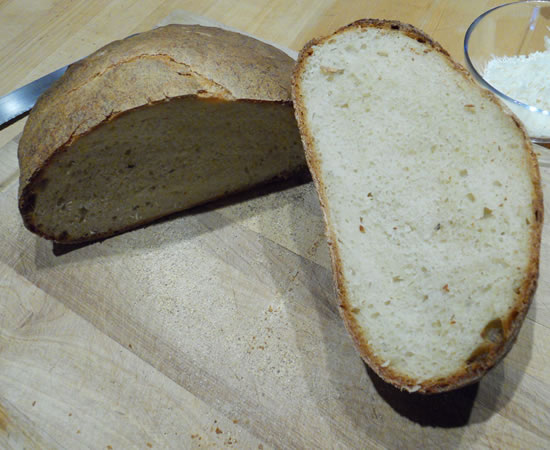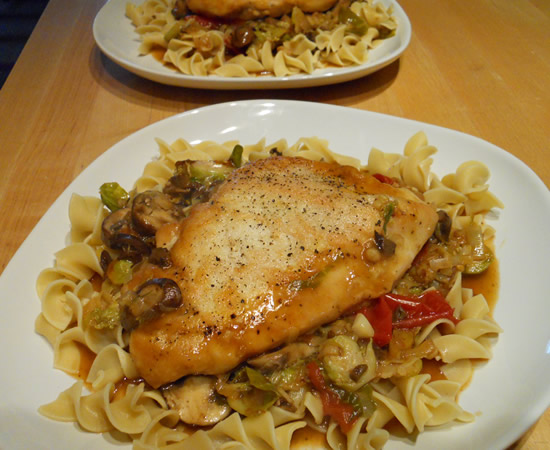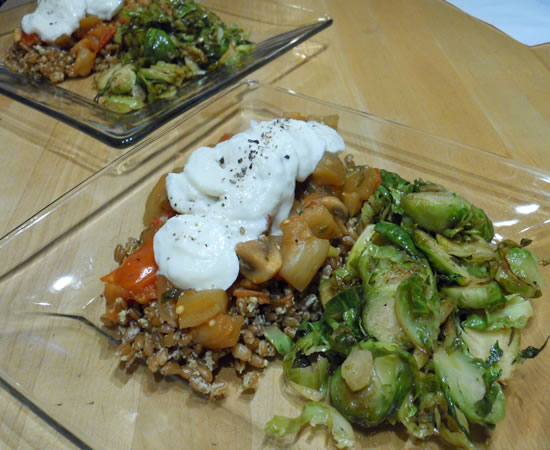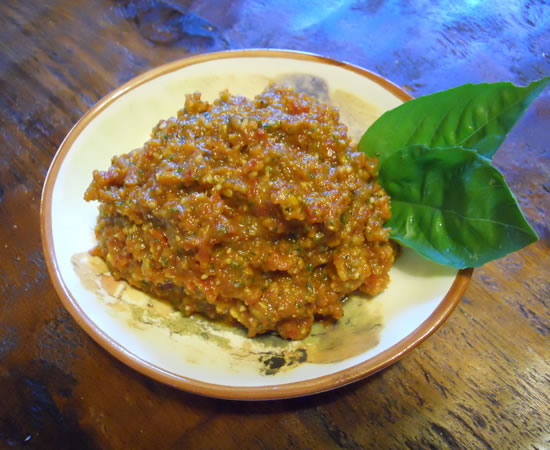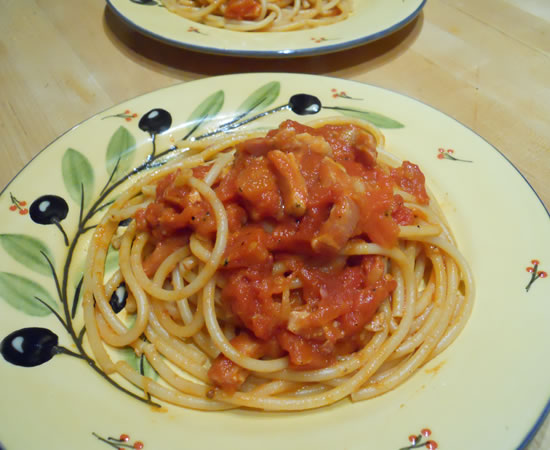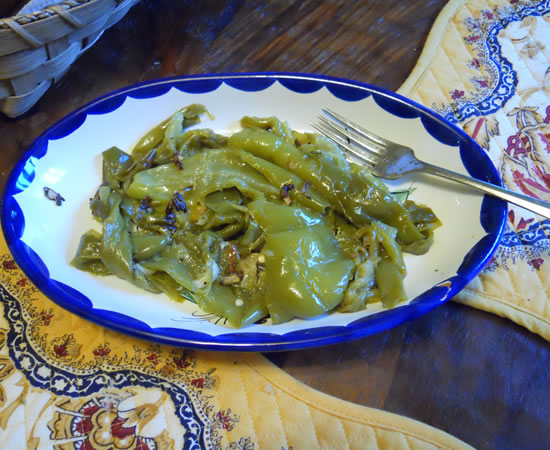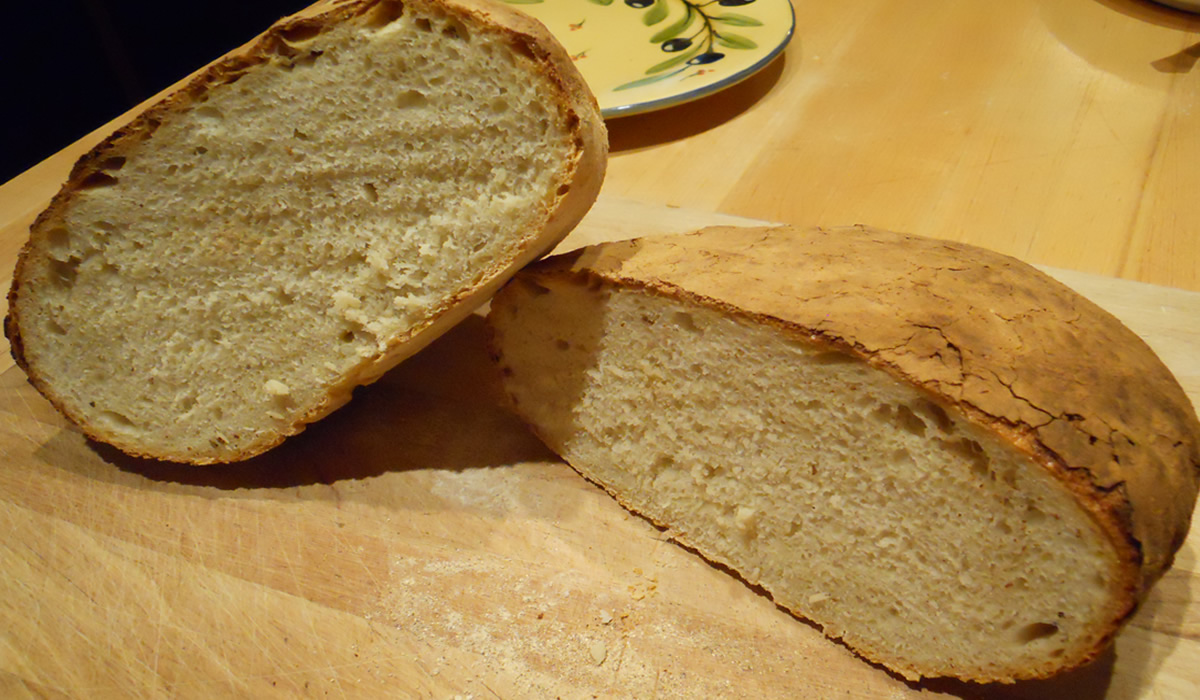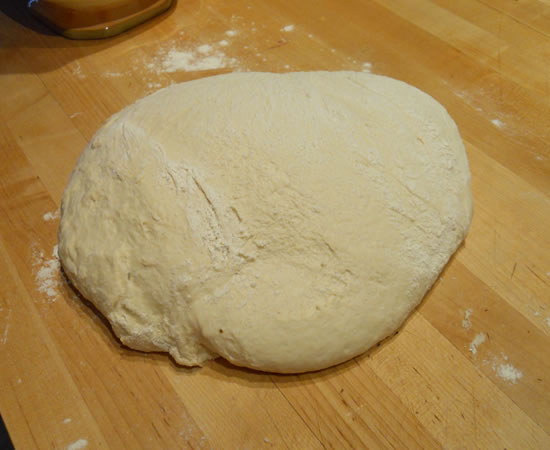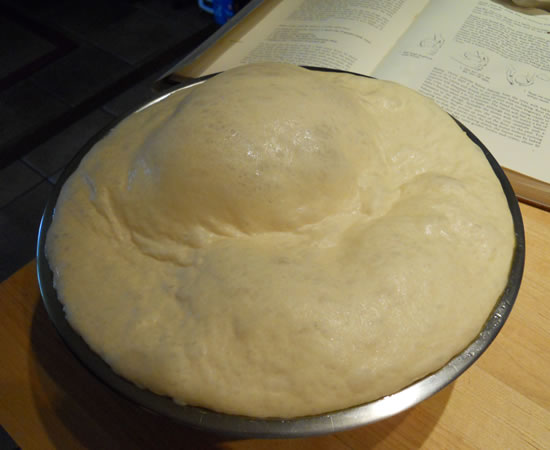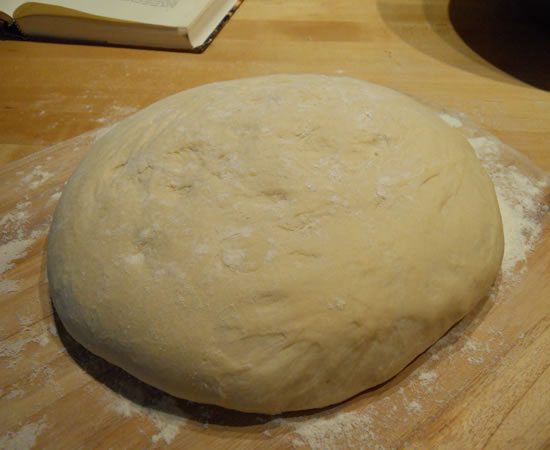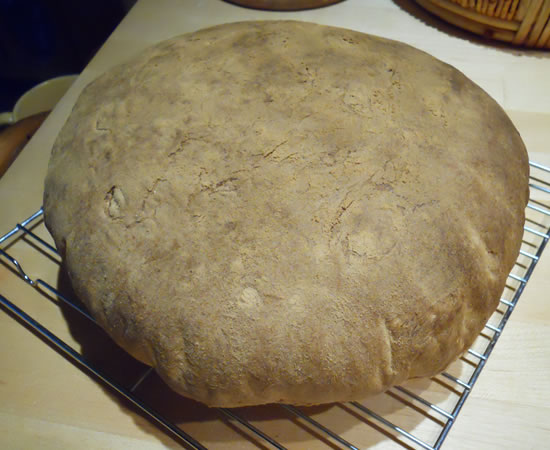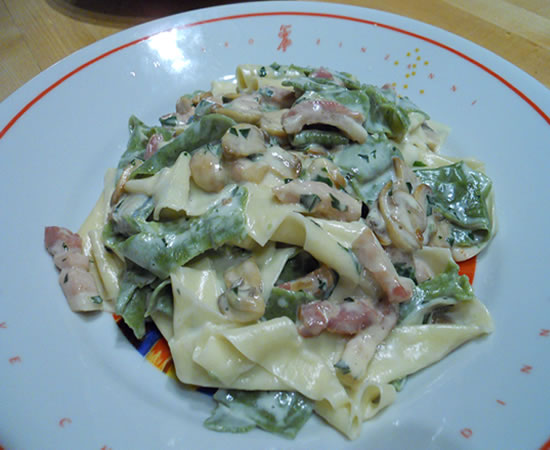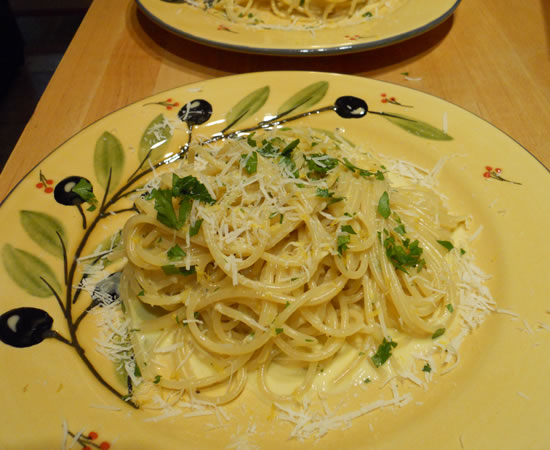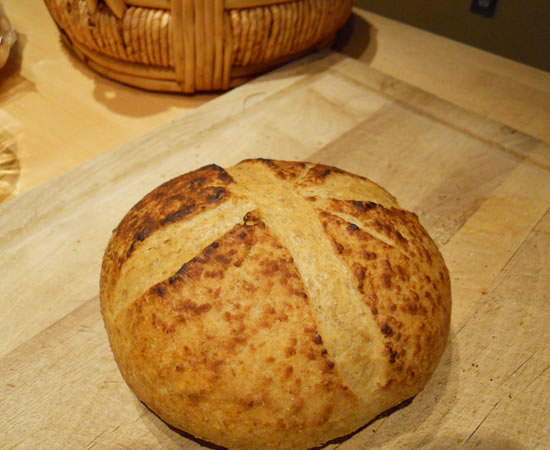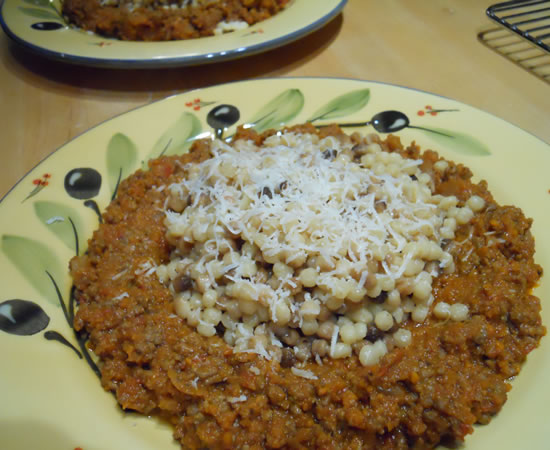Salsicci con Finocchi e Olive
It was cold and damp today - a perfect excuse for me to sit in the office and work on a website for a fun new friend. And it was a perfect day for Victor to cook dinner!
It's a bit of self-defense on his part... he knows how I can get when I'm focused on a new site and if dinner is to be anything more than hot dogs, he probably needs to cook it.
Well... my clever ruse worked and did he ever create a great dish!
The concept comes from Lidia's Italy cook book. It's a really simple dish of sausage, fennel, and olives. The recipe calls for green olives, but we didn't have any in the house, so he substituted kalamatas. He also added some malloreddus that was left from Monday's dinner to make it a one-pot dish. And cut it for the two of us.
It worked on every level. The combination of flavors and textures was perfect. I broke away from the office long enough to bake a fresh loaf of bread and it was perfect for sopping up every drop of juice on the plate.
If you haven't cooked fennel in a while - or have never cooked fennel - this is definitely the recipe to try.
Sausages with Fennel and Olives (Salsicci con Finocchi e Olive)
from Lidia's Italy
Serves 6Fresh fennel is one of my favorite companions for good Italian sausage. Here meat and vegetables are skillet-cooked, separately and then together, until their flavors are merged and concentrated. It may seem that a lot of fennel is called for, but in cooking it diminishes greatly. Fennel prepared this way is also excellent with any grilled meats; it is even good with grilled fish.
- Sausages 4 tablespoons extra-virgin olive oil
- 12 sweet Italian sausages (about 2 pounds)
- 1 cup dry white wine
- 6 plump garlic cloves, peeled and crushed
- ¼ teaspoon peperoncino flakes, or to taste
- 1 cup large green olives, squashed to open and pit them
- 3 large fennel bulbs (3½ to 4 pounds), trimmed and cut into 1-inch chunks
- ½ teaspoon coarse sea salt or kosher salt
Recommended Equipment
A 13- or 14-inch heavy-bottomed skillet or sauté pan, with a coverPour 2 tablespoons of the olive oil into the big skillet, and set over medium-high heat. Lay in all the sausages; cook them for 5 minutes or more, rolling them over occasionally, until they're nicely browned on all sides. Pour in the wine, and boil until it is reduced by half. Remove the sausages to a platter, and pour over them the wine remaining in the pan.
Add the remaining 2 tablespoons olive oil to the empty skillet, toss in the garlic cloves, and cook for a minute or so, over medium heat, until they're sizzling. Drop the peperoncino in a hot spot for a few seconds, then scatter the squashed olives in the pan; toss and cook for a couple of minutes.
Add the fennel chunks, and stir them in with the garlic and olives. Season the vegetables with ½ teaspoon salt, cover the skillet, and cook over medium-high heat for 20 minutes, tossing and stirring now and then, until the fennel softens, shrinks, and begins to color. Add a bit of water to the pan if the fennel remains hard and resistant to the bite.
When the fennel is cooked through, return the sausages and the wine to the skillet. Turn and tumble the meat and vegetables together, and cook uncovered another 5 minutes or so, until everything is deeply caramelized and glazed. Adjust the seasoning to taste; keep cooking and tumbling the sausages and fennel. Serve piping hot.
And fresh-baked bread...
Malloreddus con Salsiccia
It is so good to be me.
I know, I know... It's just not right to brag or gloat or any of that sort of stuff, but damn! it's good to be me! My stomach is smiling from here to the moon and back!
Victor was in the kitchen once again, working his way through the Pasta Issue of La Cucina Italiana. This weeks gastronomic celebration was Malloreddus con Salsiccia, or Malloreddus with Sausage.
Malloreddus is a semolina pasta from Sardinia. Sardinia, was occupied for several centuries by the Arabs after the fall of the Roman Empire, and one of the fun culinary differences from other parts of Italy is the locals acquired a taste for saffron. It is often used both in the dough and in the accompanying sauce.
Malloreddus in not gnocchi, although they share a similar shape. They have very different ingredients, textures, and flavors.
Malloreddus
- Sea Salt
- 1 ¼ cups semolina flour
- ¾ cup unbleached all purpose flour
- Extra virgin olive oil
Gnocchi board or a table fork
Dissolve 1 tsp salt in ¾ cup warm water. In a large bowl whisk together semolina and all purpose flour; mound and form a well in the center.
Add water mixture and 2 tsp olive oil to the well. Using your hand or a fork, slowly incorporate flour from inside the rim of the well. Continue until liquid is absorbed, then knead in bowl until dough forms a complete mass (dough will be slightly sticky).
Transfer dough to a well floured work surface and knead, dusting with a bit more flour as needed just to keep dough from sticking to your hands, for 5 minutes. Wrap dough tightly in plastic wrap and let rest for 30 minutes.
Break off about 1/8 of the dough; tightly rewrap remaining dough. Roll dough into ½ inch cylinder, and cut into ¼ inch thick pieces. Pressing with your thumb, roll each piece on a gnocchi board (or down the back of a fork) to give it the characteristic ridges, and put on a floured baking sheet. Repeat with the remaining dough.
To cook fresh Malloreddus, bring a large pot of salted water to a bill. Add pasta and cook until tender, about 6 minutes after water returns to a boil. Drain, transfer to a large serving bowl and immediately toss with sauce and serve.
This is less than half of the pasta. The rest went into the freezer!
Malloreddus con salsiccia – Malloreddus with sausage.
- 1 lbs sweet or hot Italian sausage
- Heaping 1/8 tsp crushed saffron threads
- 3 tbls extra virgin olive oil
- 1 medium onion, roughly chopped
- 1 (28 oz. can) whole peeled tomatoes with juices.
- ½ cup dry white wine
- Sea Salt
- 1 lbs fresh Malloreddus or dried from the store
- ½ cup freshly grated Pecorino Romano cheese plus more for serving
Remove sausage from casing, break meat apart a bit. Combine saffron and ¼ cup water in a small bowl
In a large saucepan, heat oil over medium high heat, add onion and cook, stirring frequently, until softened. 5 to 6 minutes. Add sausage, and cook, breaking meat apart with a wooden spoon for 5 minutes. Add tomatoes with juices, add wine, cook, breaking up tomatoes for 5 minutes. (Sometimes dump the tomatoes and juice in a large bowl and roughly break them up with my hands)
Add saffron mixture and ¼ tsp salt. Gently simmer sauce until thickened and flavorful, 45 to 50, minutes over medium heat. Remove from heat and cover to keep warm.
Bring a large pot of salted water to a boil. Add pasta and cook until al dente (about 6 minutes for fresh Malloreddus). Meanwhile, gently warm sauce. When pasta is al dente, drain, transfer to a large bowl, immediately add sauce and toss to combine. Add cheese and toss once more. Serve immediately with extra cheese.
I made a loaf of Pane Pugliese from dough I had frozen a couple of weeks ago. It was the perfect accompanyment to the perfect pasta dish.
While there are still lots of recipes in the magazine, we just received a copy of the latest Wegmans magazine - full of Italian Pasta Meals!
The Monday Pasta Extravaganza is going to going on for many many many more weeks to come!
It is so good to be me!
Chicken and Mushrooms with Marsala Wine Sauce
This recipe comes courtesy of Cooking Light. Well... The concept does.
I followed the guidelines, but my ingredient list was a bit different. I wanted to use up a few odds and ends in the 'fridge.
I liked the original recipe and will probably make a closer-to-the-original version one of these days. In the meantime, here's the recipe from Cooking Light with my changes following!
Chicken and Mushrooms with Marsala Wine Sauce
Yield: 4 servings (serving size: 1 chicken breast half and about 1/2 cup sauce)
Ingredients
- 1/2 cup dried porcini mushrooms (about 1/2 ounce)
- 4 (6-ounce) skinless, boneless chicken breast halves
- 4 teaspoons all-purpose flour, divided
- 3/4 teaspoon salt, divided
- 1/4 teaspoon freshly ground black pepper
- 2 tablespoons olive oil, divided
- 1/2 cup chopped onion
- 1/4 teaspoon crushed red pepper
- 5 garlic cloves, thinly sliced
- 1 1/2 cups thinly sliced shiitake mushroom caps (about 4 ounces)
- 1 1/2 cups thinly sliced button mushrooms (about 4 ounces)
- 1 teaspoon dried oregano
- 1/2 cup dry Marsala wine
- 2/3 cup fat-free, lower-sodium chicken broth
- 1 cup halved cherry tomatoes
- 1/4 cup small fresh basil leaves
Preparation
1. Place porcini mushrooms in a small bowl; cover with boiling water. Cover and let stand 30 minutes or until tender. Drain and rinse; drain well. Thinly slice.
2. Place each chicken breast half between 2 sheets of heavy-duty plastic wrap; pound chicken to 1/2-inch thickness using a meat mallet or small heavy skillet. Combine 3 teaspoons flour, 1/4 teaspoon salt, and black pepper in a shallow dish. Dredge chicken in flour mixture.
3. Heat a large stainless steel skillet over medium-high heat. Add 1 tablespoon oil to pan; swirl to coat. Add chicken; cook 3 minutes on each side or until done. Remove from pan; cover and keep warm.
4. Heat remaining 1 tablespoon oil in pan over medium-high heat. Add onion, red pepper, and garlic; sauté 2 minutes or until onion is lightly browned. Add remaining 1/2 teaspoon salt, porcini, shiitake, button mushrooms, and oregano; sauté 6 minutes or until mushrooms release moisture and darken. Sprinkle with remaining 1 teaspoon flour; cook 1 minute, stirring constantly. Stir in wine; cook 1 minute. Add broth; bring to a boil. Reduce heat, and simmer 1 minute. Add chicken and tomatoes; cook 2 minutes or until thoroughly heated, turning chicken once. Sprinkle with basil.
I used leeks instead of onion, and sliced up about 8 brussels sprouts and fried them with the leeks. I used the porcini mushrooms but used baby bellas instead of the shitake and button. I also lightly thickened the sauce with a bit of cornstarch. And my tomatoes were from the garden, not cherries.
It came out pretty good.
Pansotti con Salsa di Noci
I don't even know where to begin.
Dinner tonight was just unbelievable.
I could die right now and have lived a complete life.
This is one of those recipes that sounds wonderful but is actually even more wonderful when you taste it! Just wonderful.
Creamy good. The sauce is surprisingly silky for having so many walnuts in it. The food processor really does a good job. (It may state mortar and pestle but we cook using 20th century equipment, whenever possible!)
There is a definite garlic undercurrent to it - even though the sauce only calls for one clove. But the other flavors work together well with it. The ravioli filling actually has flavor and texture to it - something usually lacking in the store-bought variety.
The actual pasta was light enough not to be a belly bomb, but substantial enough that you knew you were eating a ravioli. A real ravioli.
Balance.
And balance pretty much sums up the whole plate.
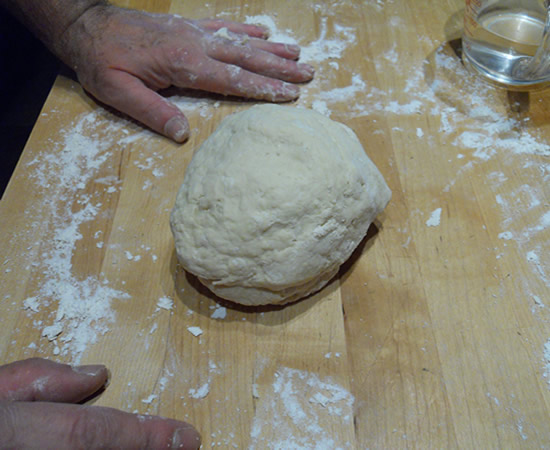
Pansotti
Dough
- 3 cups unbleached all purpose flour
- 1 1/2 tsp fine sea salt
- 1/4 cup dry white wine
- 1/3 to 1/2 cup water
- 1 large egg
In a large bowl, whisk together flour and salt. Mound flour mixture and form a well in the center. Add wine, 1/3 cup water and get to the well. Using a fork, gently break up yolk and slowly incorporate flour from inside rim of well. Continue until liquid is absorbed, then knead in bowl until dough forms a complete mass. Transfer to a well floured work surface and knead for 3 to 4 minutes more. If dough is not coming together add more water by the tablespoonful to moisten. Wrap dough tightly in plastic wrap and let rest for 30 minutes.
Unwrap dough and knead for 5 minutes. Flatten dough so that it will fit through the rollers of a hand-cranked pasta machine. Set the rollers of pasta machine at the widest setting, then feed pasta through rollers 3 or 4 times, folding and turning the pasta until it is smooth and the width of the machine.
Cut dough into 3 pieces; cover 2 pieces with a clean dishtowel. Begin rolling pasta through machine, decreasing the setting one notch at a time (do not fold or turn pasta) until the sheet is 1/8 inch thick. Cut pasta sheet into 2 pieces. Dust both sides of sheets with flour and cover 1 sheet with a clean dishtowel. Cut the other sheet of pasta into 3 inch squares. Fill each with 1 teaspoon filling. Fold into triangles and seal with a dab of water and crimp with a fork. Transfer to a clean dry lightly floured baking sheet. Repeat with the remaining pasta sheet, then roll, cut and fill remaining dough, 1 piece at a time.
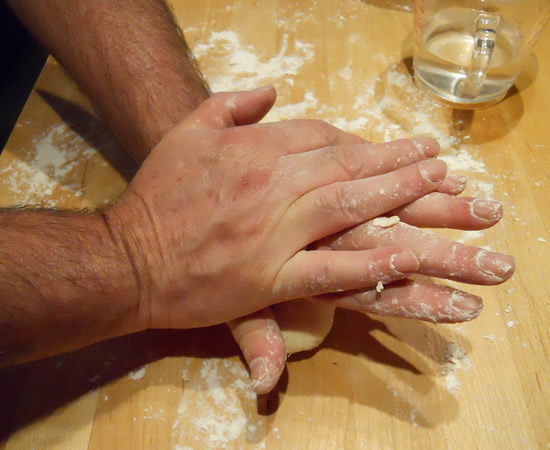
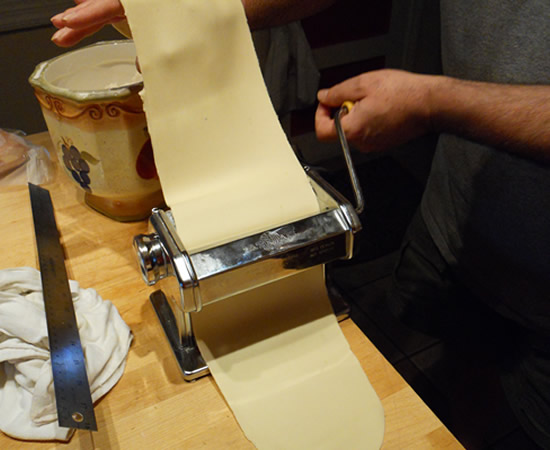
Filling
- 1 lb Swiss chard, stems and center ribs removed, leaves coarsely chopped.
- 1/3 cup finely chopped fresh basil leaves
- 1 clove garlic
- 1 tsp fine sea salt
- 3/4 cup freshly grated Parmigiano-Reggiano cheese
- 3/4 cup fresh ricotta cheese
- 1 large egg
- 1 tsp freshly ground black pepper
Bring a large pot of water to a boil. Add chard and cook for 3 minutes. Drain, then squeeze out all excess water. Finely chop together chard and basil
Mound garlic and salt on a cutting board. Using the blade and flat side of a chef’s knife, chop and blend together the garlic and salt to a paste. In a bowl, combine greens garlic paste, Parmigiano-Reggiano, ricotta, egg and pepper. Cover bowl and set aside.
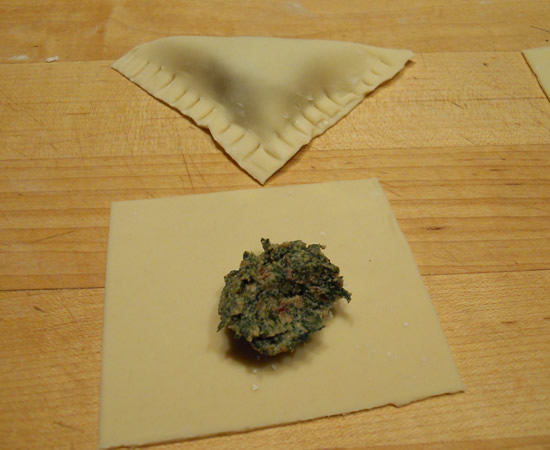
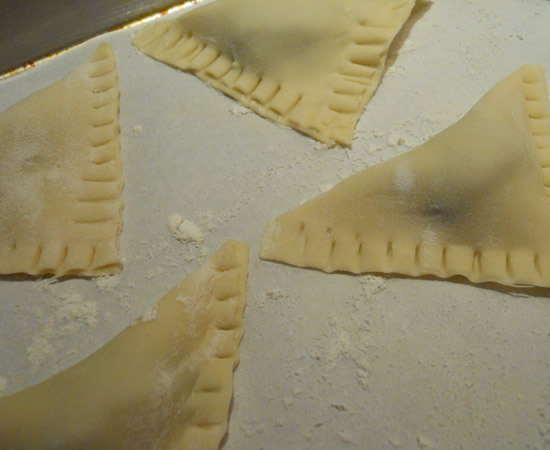
Pansotti con salsa di noci – Pansotti with walnut sauce
- 3/4 cup walnut pieces
- 1 cup (1/2 inch) cubes day-old rustic bread
- Sea Salt
- Fresh ground black pepper
- 1 garlic clove
- 1/3 cup plus 2 tbsp extra virgin olive oil
- 1/2 cup fresh ricotta cheese
- 1/4 cup nonfat Greek yogurt
- 1 batch Pansotti
Put the bread in a bowl, cover with tepid tab water and let stand for 5 minutes, then drain and squeeze out excess water
Place the walnuts, 3/4 tsp salt and a pinch of pepper into a food processor. Add the garlic and drizzle in all but 2 tbsp. of the olive oil. Add the ricotta and yogurt and the last 2 tbls oil and mix until combined.
Toss in a bowl with the warm Pansotti and serve immediately.


Dough
3 cups unbleached all purpose flour
1 ½ tsp fine sea salt
¼ cup dry white wine
1/3 to ½ cup water
1 large egg
Farro, Eggplant, and Buffalo Mozzarella
Dinner tonight was slightly different than I originally envisioned. I planned on making farrow cakes/patties, frying them, and topping them with the eggplant and tomato sauce. Alas... the farrow just didn't want to hold together in a patty shape.
No matter. It came out pretty good, nonetheless!
I had a homegrown eggplant from our neighbor up the street that I definitely wanted to use tonight. She's cute. She just leaves an eggplant or a zucchini on the table by our back door now and again. I have told her for years that I will take any and all homegrown produce she wants to send our way, but I think she's a bit embarrassed and doesn't want to be seen as the neighbor everyone hides from when they see her with her bounty. Nope. Not me. You grew it, I'll cook it. Bring it on!
So dinner tonight was actually vegetarian. Not unheard of, but not the most common for me, either. But it worked.
Because I planned on making patties from the farrow, I added an egg to help bind it. Because I added the egg, I had to saute the mixture to cook it. This recipe is for making it as a side dish without the egg, because I'll never try and make farrow patties, again.
Farrow with Gorgonzola
- 1 cup farrow (or brown rice)
- 2 oz gorgonzola
- 2 tbsp minced parsley
- 1/4 tsp garlic powder
- salt and pepper, to taste
Cook farrow (or rice) according to package instructions. Drain completely. Stir in gorgonzola, parsley, garlic powder, and S&P.
Serve
The eggplant and tomatoes were another simple saute.
Eggplant and Tomato Sauce
- 1 medium eggplant
- 6 plum tomatoes
- 1 small yellow onion
- 1 clove garlic
- 1/2 cup button mushrooms
- 1/4 cup red wine
- 1/4 cup chopped mixed fresh herbs (I used basil oregano, rosemary, and sage)
- salt and pepper, to taste
- buffalo mozzarella
Peel and dice eggplant. Sprinkle with salt and put in colander to drain - about 30 minutes.
Coarsely chop onion, garlic, tomatoes, and mushrooms. Add onion to skillet and cook until translucent. Add garlic and then mushrooms. Add wine and cook until it is almost evaporated. Add eggplant and tomatoes and cook until they release their juices and begin to break down.
Continue to cook until slightly thickened.
Stir in fresh chopped herbs and check for seasoning, adding salt and pepper, if desired.
To assemble:
Plate farrow. Spoon tomato and eggplant sauce on toip and top with slices of fresh buffalo mozzarella.
Brussels sprouts are probably my most favorite vegetable. A lot of folks don't like them because they think they're too bitter. Slicing them really thin and sauteing them with a bit of olive oil, garlic, and a drizzle of balsamic vinegar makes them a really delicious vegetable and they're not in the least bit bitter.
Really.
Basil and Sun-Dried Tomato Pestos
It's that time of year when we have more basil than we will ever be able to consume. We started off with three plants this year. One went to seed really quickly, but the other two took off. It's been great.
But there comes that moment in time when one realizes that it's either make pesto or watch it all wilt, wither, and die. The basil, of course, was cheap. The pine nuts are anything but.
There's a shortage of pine nuts. An actual world-wide shortage. It's sent prices skyrocketing; $16.00-$30.00 and more per pound! I bit the bullet and bought some today. Yes, one can substitute walnuts - and walnuts actually make a pretty good pesto - but Victor is planning a pesto pasta for his next Monday Feast, so nothing but the best, ya know?!?
He made two different pestos tonight - a traditional basil and a sun-dried tomato pesto. The traditional is from la Cucina Italiana, the sun-dried tomato is his own.
From Victor:
Genevese Pesto
- 1 ¾ cups packed fresh basil leaves
- ¼ cup pine nuts
- 2 large cloves of peeled garlic
- 1 ¼ cups freshly grated Parmigiano-Reggiano or Pecorino or Parmesan cheese (any GOOD fresh grated cheese)
- 1/3 cup extra virgin olive oil.
- Salt-Pepper to taste
Now if you are REALLY brave and want to be authentic do the following.
Get your mortar and pestle (yes YOUR mortar and pestle. What do you mean you don’t have one??). Put about ½ of the basil in the mortar. Using the pestle with a rotary movement, grind the basil against the wall of the mortar until mostly ground, then, in batches, repeat with remaining basil until all the leaves are ground.
Working with 1 tablespoon at a time, add and grind pine nuts, then add garlic (thinly sliced) and a generous pinch of salt: grind until garlic is ground.
Working with 1 to 2 tablespoons at a time add and grind cheese.
Working with 1 to 2 tablespoons at a time, drizzle in oil, grinding and mixing to incorporate as you go, until the pesto is combined and smooth.
OR……do what I do and place all ingredients in a food processor with the metal blade and pulse until coarsely chopped. Then with the machine running, pour the olive oil slowly down the tube until everything is incorporated and finely minced. Taste and adjust salt and pepper if necessary.
Sun Dried Tomato Pesto
- Approx. 8-9 oz. sun dried tomatoes (dry, not in olive oil)
- 1 cup (packed fresh basil leaves
- ½ cup freshly grated Parmesan cheese
- 2 cloves of garlic – peeled
- ¼ cup pine nuts
- Salt-Pepper to taste
- 1/3 cup extra virgin olive oil
Put all the ingredients, except the olive oil, in a food processor with the metal blade and pulse until coarsely chopped. Then with the machine running, pour the olive oil slowly down the tube until everything is incorporated and finely minced. Taste and adjust salt and pepper if necessary.
For Penne pasta with Sun Dried Tomato Pesto – cook 1 lb. penne according to package directions. When the pasta is al dente, reserve about a ½ cup of the pasta water and drain the pasta. In a large serving bowl add the pesto and the hot pasta and toss to coat adding just enough of the pasta water to moisten. Serve with extra Parmesan cheese.
We're eating well around our house!
Balsamic Zabaglione
A great Italian dinner calls for an Italian dessert.
I got the idea for this from Bon Appetit. I changed things around because...well... that's what I do. Besides... I needed to work with the ingredients I had at home.
Balsamic Zabaglione
- 1 cup heavy cream
- 4 egg yolks
- 1/4 cup sugar
- 1/4 cup Marsala
- 1 tbsp good quality balsamic vinegar
- 1 pint blackberries
- 3 golden plums
- 1/4 cup Marsala
- 1/4 cup honey
For zabaglione, whip cream to stiff peaks and refrigerate.
Whisk the egg yolks with the sugar, marsala, and balsamic vinegar. Place the bowl over a saucepan of simmering water and beat with hand-held mixer until the mixture is thick and foamy. Remove the bowl from the heat and continue beatinging until the zabaglione is completely cool.
Gently fold the zabaglione into the whipped cream and chill.
Meanwhile, place the fruit in a large bowl. In a small saucepan, bring the marsala and honey to a boil. Add the fruit and toss to coat. Spoon the fruit into wine glasses and top with zabaglione.
It was the perfect ending to a perfect meal.
Back to reality, tomorrow.
Bucatini all'amatriciana
At the dinner table, I was telling Victor I didn't know how I was going to write this post without sounding like I was gloating.
Sorry. I'm gloating. This was one fine dish!
It has a simplicity of ingredients and a complexity of flavor that works on every level.
For years we've listened to Lidia Bastianich talk about letting a few simple ingredients be the show and not covering them up with a hundred conflicting flavors.
Now, don't get me wrong... I love my hundred conflicting flavors, too - curries and different spice blends are out of this world. But there's something about bringing just a few ingredients together and getting huge flavor from them that is truly magical.
Another thing I notice more and more as I get older is how the shape of the pasta affects the dish. As a kid growing up, we had spaghetti, vermicelli, elbow macaroni, and lasagne noodles. That was it. It took me going to work in Italian restaurants to learn what mostaccioli and rigatoni were. I didn't have ziti until I moved to the east coast! It amazed me that there would be a dozen different sizes and shapes of pasta on the shelf at the grocery store. It's taken me a while but I now understand why.
Fast-forward to tonight's dinner, and, while I think the sauce would be downright excellent with any pasta, the bucatini really does make it the perfect dish.
Bucatini all'amatriciana
- 1 ½ lbs tomatoes
- 5 oz guanciale
- 3 tbs extra virgin olive oil
- 1 - 2 garlic cloves, gently smashed and peeled
- 1 medium onion thinly sliced
- 1 tsp (or more to taste) crushed red pepper flakes
- ¼ cup dry white wine
- Sea Salt
- 1 lb bucatini
- 2/4 cup freshly grated Pecorino Romano cheese
- Fresh ground Pepper
Before I give you the directions, let me say a couple things – Guanciale is pig jowls or actually the cheeks of the pig and it is very hard to find. You need to go to a good Italian butcher, however you may substitute pancetta. Second, I used fresh tomatoes from our garden which required me to do step one below and peel, seed and dice. Its labor intensive but worth it. You can certainly use canned tomatoes; just make sure you get good ones.
OK:
Bring a large saucepan of water to a boil. Add tomatoes and cook for 30 seconds, then drain. Peel the tomatoes, cut into quarters (seed if you want to) and set aside.
Cut the guanciale into matchsticks.
In a large saucepan, combine guanciale, oil and garlic. Cook over medium heat, stirring occasionally, until garlic begins to turn golden, about 7 minutes. Using a slotted spoon, remove the garlic from the pot. (If it burns it gets bitter)
Add sliced onion and red pepper flakes to pot and continue cooking, stirring occasionally until the onion is softened, about 6 minutes. Add the wine and increase the heat to medium-high and cook until the wine has almost evaporated, about 3 minutes. Stir in the tomatoes, reduce heat to low and gently simmer, covered, until sauce is rich and flavorful, about 40-50 minutes. Remove from heat.
Bring a large pot of salted water to a boil. Add bucatini and cook until al dente. Meanwhile gently reheat sauce. When the pasta is al dente, drain, transfer to a large bowl, add sauce and toss to combine. Serve immediately with grated cheese and fresh ground pepper.
Victor also roasted some garlic and mixed it with a few of the fried peppers. It went really good atop buttered slices of homemade bread.
And what will next Monday bring?!?
Pane Pugliese
Victor's making his Monday Masterpiece, so I've baked a loaf of bread to go along with it.
The Pane Pugliese is a rustic bread from Puglia. Puglia is Italy's heel - and the perfect accompaniment to tonight's pasta sensation!
The bread calls for a biga - a starter - that needs to be made the day before.
This recipe comes from The Italian Baker by Carol Field. It's one of the few cook books we didn't get rid of a few years ago. I've been making this particular bread forever - and really do like it.
Pane Pugliese
- 1 packet dry yeast (or 1/2 package fresh yeast)
- 1/4 cup warm water
- 3 cups water; room temp
- 1 cup biga
- 7 1/2 cups all-purpose flour
- 1 tbsp salt
Proof the yeast in the warm water. Add 1 1/2 c water and the biga, mix till blended. Add flour and salt, mix till dough comes together and pulls off the sides of the bowl. Knead 3-5 minutes in a mixer, longer by hand. Dough will be very soft and elastic. Let rise about 3 hours, shape into 2 small round loaves or 1 big flattish one. If you have baking stones, place loaves on baking peel or on baking sheets sprinkled corn meal. Let rise about 1 hour. Preheat oven to 450°, and 10 minutes before baking flour the loaf tops and dimple them with your fingers. Bake 50-60 minutes for big loaves, 30-35 minutes for small. Tap the loaves to test for doneness (hollow=done) and cool on a rack.
And the biga. I would imagine it could stay in the 'fridge and just keep adding to it as I used to do with my starters years ago.
The bread is wild. It rises wild, it bakes wild. It really has a mind of its own. One of the reasons I really like it. The unpredictability is what makes it fun.
Biga
- 1/2 tsp active dry yeast (or 1/10 package fresh yeast)
- 1/4 cup warm water
- 1 1/4 cup water (room temperature)
- 3 3/4 cups unbleached all-purpose flour
Stir the yeast into the warm water and let stand until creamy – about 10 minutes. Stir in the remaining water and then the flour, one cup at a time.
Mix with the paddle attachment on the mixer at the lowest speed about 2 minutes.
Remove to a slightly oiled bowl, cover, and let rise at cool room temperature for 6 to 24 hours. The starter will triple in volume and still be wet and sticky when ready. Cover and refrigerate until ready to use.
I made one loaf and froze the rest of the dough - as well as the biga.
Ready to go into the hot oven!
This bread is stellar! It is really crusty with a great interior.
I can't wait for dinner!
Tagliatelle 'Paglia e Fieno' con Prosciutto e Funghi
Oh.My.God.
I have died and gone to gastronomic heaven. And I'm loving every bit of it.
Victor has once again shown why I love La Cucina Italiana Magazine. And this months, The Pasta Issue.
After the fantastic pasta from yesterday, Victor decreed that, on Mondays, he would be making all of the various pasta dishes in the magazine. Starting today.
Today was Tagliatelle 'Paglia e Fieno' con Prosciutto e Funghi. "Straw and Hay" Tagliatelle with Prosciutto and Mushrooms. The straw is the yellow pasta,, the hay is the green. Colorful names, these Italians have for their foods, eh? But colorful names aside, the key to this is the homemade pasta. And Victor made the lightest, most wonderful flavorful pasta one could ever imagine. Firm, yet silken. With body and substance without heaviness.
Perfection.
We've had the pasta roller for years and I do have to admit I haven't pulled it out in months. But after tonight, I think it's going to be a regular visitor in the kitchen - especially this fall and winter.
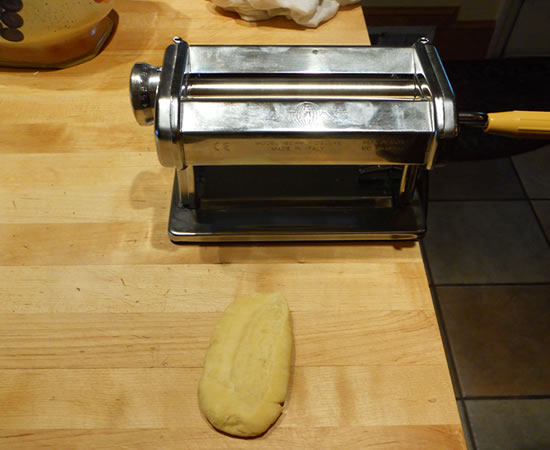
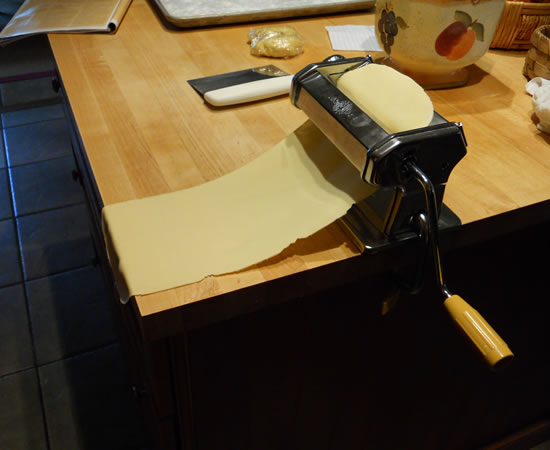
Tagliatelle “paglia e fieno” – (Straw and Hay” Tagliatelle)
Makes about 14 oz of Pasta.
- 4oz fresh spinach
- Fine sea salt
- 2 cups unbleached all-purpose flour
- 2 large eggs
- 2 large egg yolks
Parchment paper or wax paper
Trim stems from spinach, discard stems. Rinse leaves in cold water, do not dry.
In a medium saucepan with a pinch of salt, cook spinach over medium heat covered, until tender, 3 to 5 minutes.
Drain spinach and let cool, then gently but thoroughly squeeze out excess liquid and very finely chop.On a clean work surface, mound 1 cup flour and form a well in the center.
Add 1 egg, 1 egg yolk and spinach into the well. Using a fork (or your fingers) gently break up yolk and slowly incorporate flour . Continue until the liquid is absorbed, then knead for 10 minutes.
Wrap dough tightly in plastic and let rest for 30 minutesRepeat the process above with the flour and eggs to make the other half of the dough. Knead for 10 minutes and wrap in plastic and let rest for 30 minutes
After the dough has rested:
- Take the spinach dough and divide into 3 equal pieces (cover the other two and set aside)
- Set the rollers of pasta machine at the widest setting then feed pasta through rollers 3 or 4 times folding and turning pasta until it is smooth and the width of the machine.
- Roll dough through the machine, decreasing the setting one notch at a time (do not fold or turn the dough this time) until pasta sheet is a scant 1/16 inch thick.
- Cut sheet in half crosswise, lightly dust both sides with flour. Layer sheets between floured pieces of parchment or wax paper.
- Repeat the process until both types of dough is rolled out.
Cutting:
- Loosely roll up the pasta sheet and with a very sharp chefs knife, cut rolled sheet crosswise into ¼ inch strips.
- Unroll ribbons of pasta, lightly dust with flour and spread on a lightly floured baking sheet.
- Repeat with remaining pasta sheets.
To cook:
- Bring a large pot of salted water to a boil.
- Add Tagliatelle and cook until tender – about 3 minutes…no more.
- Drain and sauce with whatever sauce you are using.
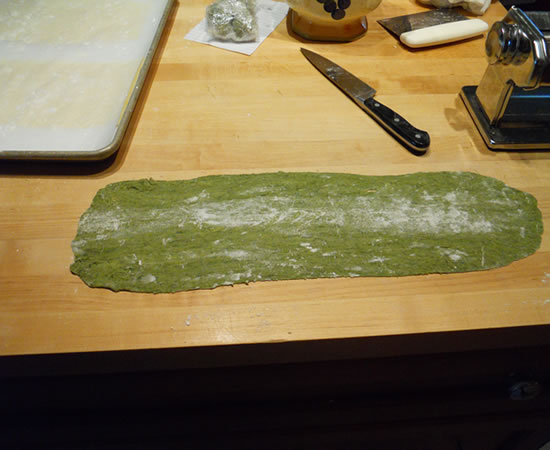
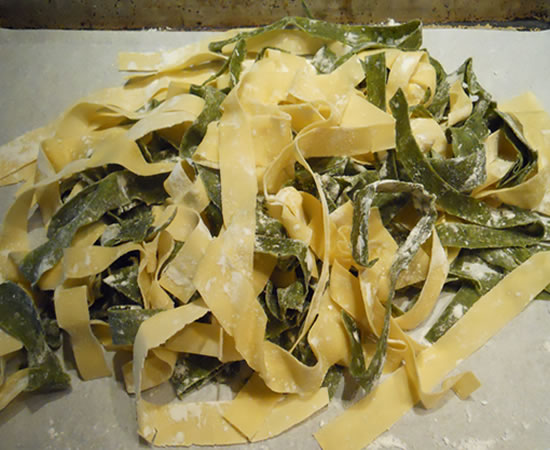
Tagliatelle “paglia e fieno” con prosciutto e funghi – Straw and Hay Tagliatelle with Prosciutto and Mushrooms.
- Fine sea salt
- 6 oz 1/8 inch thick slices prosciutto – cut into matchsticks
- ½ lb button mushrooms, trimmed and sliced
- 1 large shallot, finely chopped
- 2 tbls unsalted butter
- 3 large or 5 small sage leaves
- 1 cup heavy cream
- ¼ cup finely chopped flat leaf parsley
- ¼ cup finely grated Grana Padano or Parmigiano Reggiano cheese
1 recipe (14 oz) fresh straw and hay Tagliatelle or 14 oz dried from the store.
- Bring a large pot of salted water to a boil.
- In a large skillet, combine shallot, butter and sage, heat over medium-high heat, stirring occasionally until butter is melted.
- Add mushrooms and cook, stirring for 1 minute.
- Remove sage leaves at this point and add the matchstick prosciutto and cook until golden, but still tender (about 3 minutes)
- Add cream to the skillet, bring to a simmer and cook for 1 minute.
- Stir in parsley and cheese, remove sauce from heat.
- When pasta is al dente, reserving ¼ cup of pasta water, drain pasta and add to the skillet with the hot sauce. Add a bit of the pasta water only if you feel you need to thin the sauce a bit. Toss.
- Serve and eat immediately.
I bought a loaf of fresh-baked crusty Italian bread at the store today in anticipation of this dinner. I sliced it - and didn't touch a slice. I was too busy loving every bite of the pasta.
And while it looks like a lot of work, it's not, really. And trust me - it is worth every second spent in the kitchen.
I can't wait until next Monday!
Tagliatelle “paglia e fieno” – (Straw and Hay” Tagliatelle)
Makes about 14 oz of Pasta.
4oz fresh spinach
Fine sea salt
2 cups unbleached all-purpose flour
2 large eggs
2 large egg yolks
Parchment paper or wax paper
Trim stems from spinach, discard stems. Rinse leaves in cold water, do not dry.
In a medium saucepan with a pinch of salt, cook spinach over medium heat covered, until tender, 3 to 5 minutes.
Drain spinach and let cool, then gently but thoroughly squeeze out excess liquid and very finely chop.
On a clean work surface, mound 1 cup flour and form a well in the center.
Add 1 egg, 1 egg yolk and spinach into the well. Using a fork (or your fingers) gently break up yolk and slowly incorporate flour . Continue until the liquid is absorbed, then knead for 10 minutes.
Wrap dough tightly in plastic and let rest for 30 minutes
Repeat the process above with the flour and eggs to make the other half of the dough. Knead for 10 minutes and wrap in plastic and let rest for 30 minutes
After the dough has rested:
Take the spinach dough and divide into 3 equal pieces (cover the other two and set aside)
Set the rollers of pasta machine at the widest setting then feed pasta through rollers 3 or 4 times folding and turning pasta until it is smooth and the width of the machine.
Roll dough through the machine, decreasing the setting one notch at a time (do not fold or turn the dough this time) until pasta sheet is a scant 1/16 inch thick.
Cut sheet in half crosswise, lightly dust both sides with flour. Layer sheets between floured pieces of parchment or wax paper.
Repeat the process until both types of dough is rolled out.
Cutting:
Loosely roll up the pasta sheet and with a very sharp chefs knife, cut rolled sheet crosswise into ¼ inch strips.
Unroll ribbons of pasta, lightly dust with flour and spread on a lightly floured baking sheet.
Repeat with remaining pasta sheets.
To cook:
Bring a large pot of salted water to a boil. Add Tagliatelle and cook until tender – about 3 minutes…no more. Drain and sauce with whatever sauce you are using.
Linguine al Limone
We were supposed to meet friends at a local church Italian Festival at 5pm. We didn't see them, didn't see a lot of 'festival" and it started raining. We came home.
Victor, who had been eyeing my most recent copy of La Cucina Italiana announced he was cooking dinner. I, of course, am no fool. I agreed heartily and left the kitchen.
The latest issue is The Pasta Issue. Pasta to an Italian is like - well... Pasta to an Italian. They just go together like Fred and Ginger, or Fred and Ethel, or Ethel and Merman. A perfect pairing no matter how you say it.
Tonight's pasta was Linguine al Limone. Linguine with Lemon. An interesting combination and one neither of us had tried before. And we had all the ingredients!
Linguine al Limone
- 1 pound linguine
- 4 large egg yolks
- 2 lemons
- 1/2 cup plus 2 tbsp freshly grated Grana Padano or Parmigiano-Reggiano plus more for sprinkling
- 1/2 tsp freshly ground black pepper
- 1/2 cup plus 2 tbsp heavy cream
- 1/3 cup plus 1 tbsp whole milk
- 3 tbsp finely chopped flat-leaf parsley
- 2 tbsp finely chopped chives
Bring a large pot of salted water to a boil. Add pasta and cook until al dente. Meanwhile, place egg yolks in a large bowl. Grate the zest of 1 lemon into the bowl. Add cheese and pepper; whisk to combine, then whisk in cream, milk, parsley, chives, and generous pinch of salt.
When pasta is al dente, drain and return to pot. Immediately add egg mixture and toss together to combine well, then divide among serving bowls. Grate fresh lemon zest (from the remaining lemon) and cheese over the top. Serve immediately.
This totally rocked. Totally and Completely. As in I cleaned my plate. Totally and Completely.
It absolutely had everything going for it. The flavors were perfect, nothing was overly-pronounced (I won't say I was concerned about the amount of lemon, but I did think it would be stronger) and it was perfectly balanced. I was impressed. So was Victor.
The best thing about this is Victor is going to make ALL of the pasta recipes in the magazine! Monday Pasta Day is being introduced - hopefully starting tomorrow!
I'll supply the bread.
Speaking of...
Another loaf of the no-knead bread. I brushed butter and garlic on top before I baked it.
Yum.
I can't wait for dinner tomorrow!
Sardinian Couscous
I've just been introduced to Israeli Couscous' tastier Italian cousin, Sardinian Couscous, or Fregola Sarda (or just Fregola). It is a rougher, coarser - and toasted - couscous variation. And I like it. A lot!
There's more body and substance. It is durum wheat toasted pasta that is made by rubbing (fregare means 'to rub' in Italian) coarse semolina pasta and water together to make large granules which are then toasted.
Naturally, my rendition was about as Sardinian as I am, but it was pretty good for an Irish boy who's never been to Italy - let alone Sardinia!
I made a really thick ragu with ground beef, minced carrots, minced celery, minced onion, minced garlic, fresh tomatoes (I put it all in the food processor) with salt, pepper, fresh basil, oregano, and rosemary. I cooked it with some red wine, and just let it get thicker and thicker. A bit of asiago finished it off in the pot.
I purposely kept the couscous plain because I wanted to get a feeling for what it was like on its own. Next time around I will play with it.
And the leftover ragu?!? It's gonna make an outrageous sloppy joe tomorrow!

